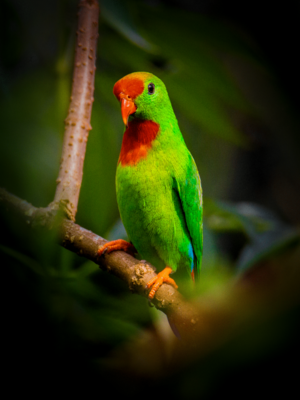Philippine hanging parrot facts for kids
Quick facts for kids Philippine hanging parrot |
|
|---|---|
 |
|
| Conservation status | |
| Scientific classification | |
| Genus: |
Loriculus
|
| Species: |
philippensis
|
The Philippine hanging parrot (Loriculus philippensis) is a small, colorful parrot. People also call it the colasisi, which comes from its local Tagalog name "kulasisi". This parrot lives only in the Philippines.
There are about eleven different types, or subspecies, of this parrot. Some of these types might even be separate species. While the Philippine hanging parrot is not currently in great danger overall, some types, like those from Cebu and Siquijor islands, might already be gone forever. The biggest danger to these birds is people catching them to sell as pets.
Philippine hanging parrots are mostly green. They have patches of red, orange, yellow, and blue on their heads and chests. These colors can be different depending on the specific type of parrot. Males usually have a red patch on their chest. However, on Camiguin island, both male and female parrots do not have this red patch. These parrots build their nests in tree holes. It's unusual for a parrot, but the female carries nesting material back to the nest.
Contents
What Does the Philippine Hanging Parrot Look Like?
Philippine hanging parrots are small, about 14 cm (5.5 in) long. They weigh between 32 and 40 g. They have a short, round tail. Their bodies are mainly green. They also have colorful spots of red, orange, yellow, and blue. These colors change depending on the specific type of parrot.
Their forehead is red, and their eyes are dark brown. Adult parrots have red beaks and orange legs. But one type, called Loriculus (philippensis) bonapartei, has black beaks and gray legs. Males and females look a bit different. Only the males have red on their chin or upper chest. The only exception is the Loriculus (philippensis) camiguinensis type. In this group, neither the male nor the female has a red chest. Young parrots have less red on their heads and lighter beaks. Otherwise, they look like the female parrots.
Where Do Philippine Hanging Parrots Live?
The Philippine hanging parrot lives naturally in the Philippines. However, you won't find them in the Sulu Archipelago or everywhere on Palawan island. Different types of these parrots live on different islands. Some types are very rare or almost gone.
Sometimes, people move these birds between islands as pets. If these pets escape, they might end up living on an island where they don't naturally belong. These parrots like to live in tropical forests. They can be found in moist lowland forests, bamboo forests, and moist mountain forests. They also live in areas changed by humans, like coconut farms and new forests that have grown back. They are most common in lower areas, rarely living above 1250 meters (about 4,100 feet).
Behaviour and Life Cycle

Philippine hanging parrots are usually seen alone or in pairs. It's rare to see them in small groups. They mostly look for food high up in the trees or in the middle parts of the forest. Their diet includes nectar and flowers. They also eat soft fruits, like those from fig trees.
These parrots breed at certain times of the year, usually from March to May. Like most parrots, they make their nests in holes or hollows. One nest found in the wild was in a high hole in a dead tree. What's special about them is that the female parrot carries nesting material back to the nest. She tucks the material between her feathers to bring it to the nest.
When kept in human care, females usually lay 3 eggs. The eggs hatch after about 20 days. The baby birds, called chicks, are ready to leave the nest after about 35 days. The eggs are round and measure about 18.7 x 16.4 mm.
Images for kids



